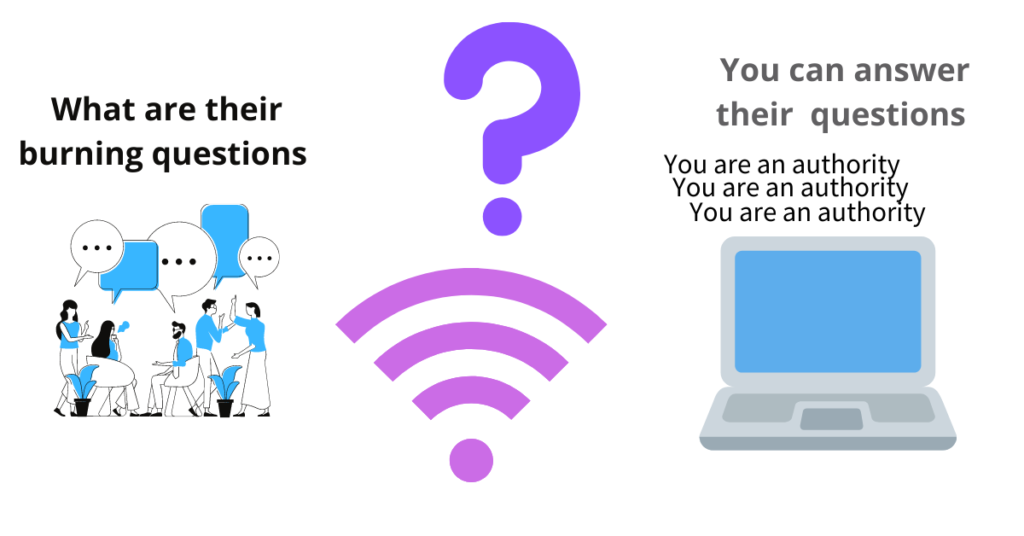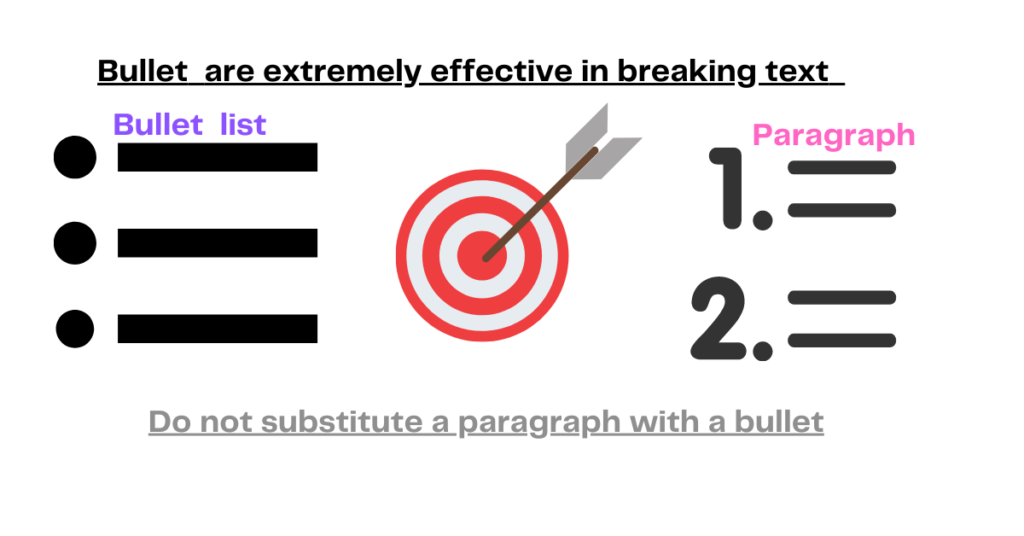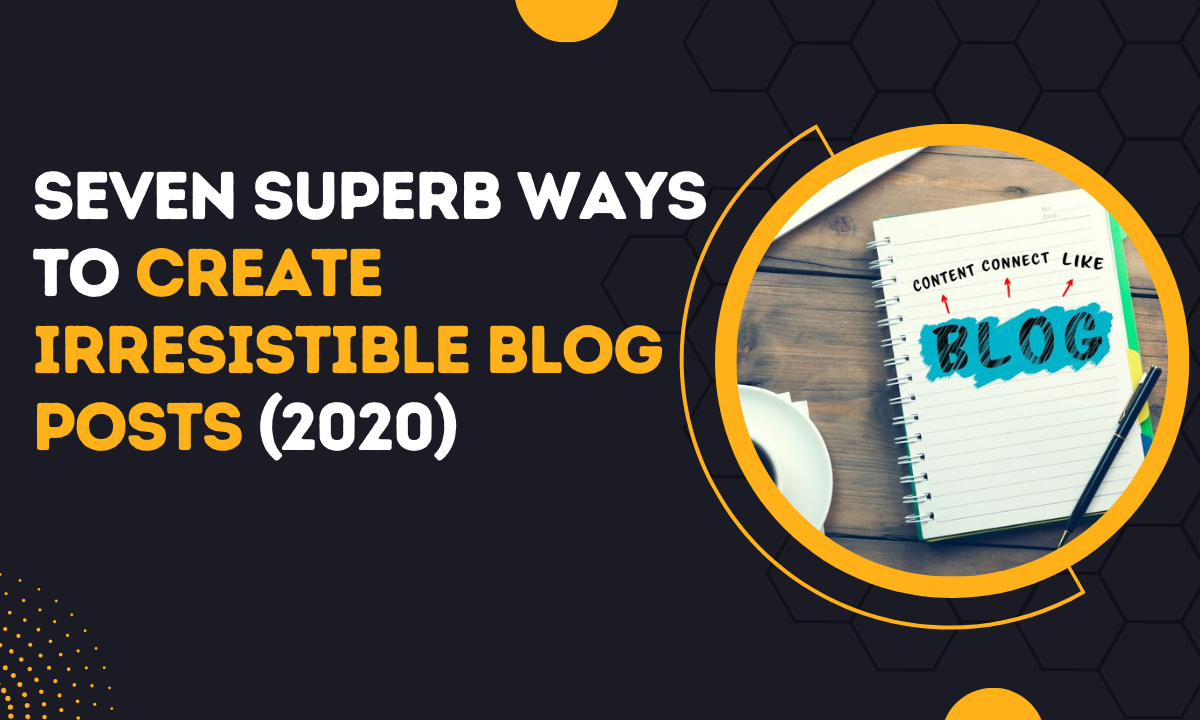7 Superb Ways to Create Irresistible Blog Posts (2020)
Want to create irresistible blog posts? But not sure if you’re doing it right? Well never mind. Because writing challenges hit all bloggers in the beginning. And later in their blogging journey as well.
Yet there are time tested rules for improving just that.
Before you aspire to create viral posts, it’s best to remember that readers online just don’t have time. Neither patience.
Instead, on average, you’ve got just under 10 seconds to capture their attention.
And do you know?…….
According to a popular online statistic, page rankings plummet to zero when readers spend less than 10 seconds on your post.
Usually, readers will skim your post. Perhaps they’ll give you a once over initially.

Maybe they’ll skim over your subheadings.
And based on that skimming, decide to stay.
Or leave.
Time taken? Anything from 3 to 10 seconds.
And there goes your “well crafted” post!
Disheartening?
Well, no big deal. That’s been happening forever to most bloggers. And continues to. But don’t throw that towel in too soon.
There is a ray of hope. It’s a tested method that’s worked for me.
Want to know?
Lets dive right in.
1. Firstly Understand Your Audience
Now when you start blogging, remember you’re creating compelling, irresistible blog posts for someone else.
Not yourself.
That person is your reader.
That’s why it’s vital to know what interests them, what they like most.
And to do that, it’s best to keep the guesswork out. That’s done by delving into some research and study.
It appears tedious. And time-consuming. But it’s not really.
The encouraging part is that there are plenty of resources for research.
A lot of bloggers get enormous inputs from “competitor marketing monitoring”.
Sounds geeky.

But it is simply studying what your readers are interested in. What they’re responding to, etc. This tells you their interests.
You come to know their burning questions.
Here I’ll add another consolation. That it is very likely you know much more than your readers.
Don’t give up on yourself. More often than not, you know more than you admit to yourself too!
Perhaps you can quench their thirst.
Perhaps you have an original perspective to offer somewhere there.
Who knows? With your hidden knowledge, you may emerge as an authority of sorts. You end up offering them answers and greater value for their queries.
You may not know this. But scores of successful bloggers started out underestimating themselves initially.
Interestingly a lot depends on how well you understand what your readers are doing on the competitor’s site.
You only need to slowly build a ‘competitor analysis summary’.

But how do you do that?
Sounds difficult. But it really isn’t.
There are a host of tools to help you along, like Semrush, Quora, Buzzsumo, Google Alerts.
I’m not delving into the entire platter here. That’s a story for another day.
Only for example’s sake let’s take Buzzsumo and Google Alerts.
With Buzzsumo Alerts, you can manage most competitor monitoring. Their search engine focuses on content, so you receive alerts on searches that interest you most. For example inputs from high traffic blogs in your niche.
Google Alerts is comparatively simple. But it eases your working because you can get alerts for your focussed interest. In fact, you can set alerts for various topics. You can also set periodicity for your alerts, whether weekly or daily.
Again no delving into details yet. I’ll leave that for another time.
2. Create Irresistible Headlines
Now before you get on to anything else, tackle your headline first.
Draft, redraft and re-redraft that headline.
Experts recommended that you should write at least 7 headlines before you finally settle for one.
Because if you don’t have a compelling headline then no one’s reading your blog.
Period.
Here’s the deal.
In the US alone there are about 31 million bloggers.
And according to an online survey, only a handful (25%) bloggers write out 7+ headlines for their articles.
Its important to remember that lukewarm headlines won’t serve you.
That’s because we’re shallow as human beings. And we’re prone to judging a post by its title.

The content in the post matters only later.
For great headlines, therefore, you need ‘headline analyzer tools’. They offer a fascinating variety of solutions
For one, they help you enhance the emotional value of a headline.
For example, Advance Marketing Institute analyses your headline’s ‘EMV level’. EMV is the emotional marketing value. After you enter your headline into the tab and press enter, your headline receives a percentage score. That is its EMV.
Similarly, you have tools that help you find varying options for the same headline. The more the better.
Some other handy tools are:-
- CoSchedule Headline Analyzer (best free headline analyzer)
- OptinMonster’s Headline Analyser
- Sharethrough Headline Analyzer
Well, there is a mountain of information on headlines, but we also must keep our subheads in focus.
That’s what we’re doing next.
3. Use Subheadings To Break Content
Whether you admit it or not, we all have become expert scanners of online content. I do it too.
Usually, while reading a book you may stay mesmerized for hours with page after page of copious text.
Reading a blog post is different though. Here, a wall of text is daunting. And repelling.
Your reflex is to turn and run.
Far away from that blog.
But when you see a ‘shapely’ blog post, you tend to linger. And fortunately, read.
Formatting gives a post that shapeliness.
And this formatting happens when you like a gardener, ‘plant’ some great subheadings.
Subheadings break up your content and add that necessary scan-ability to your post.

Besides, if enthused by the content, subheads also compel the reader to slow down. Then they actually READ your content.
So I recommend you break your blog post into several paragraphs, the shorter the better.
Cap your paragraphs with subheads. Preferably bold. Just make sure the subhead announces what’s carried in the paragraph.
Keep your sentences short. Studies recommend not more than 20 words per sentence. Remember you’re writing for an online audience. Not for researchers in a drab lab.
Normally a subhead should deliver through these arms:-
- Curiosity
- Surprise
- Personality
- Emotion
Again I’m deliberately not plunging into any of these today.
But just know, you will be served well to stay conscious of these ingredients.
The really impressive subheads contain at least one or more of these. They simply pull in and compel the readers to plow onward.
There’s something more you can do for interesting content, besides churning short paragraphs and subheadings.
Here’s what ….
4. Pump in Bullet Lists
You see the average blog reader is not into lazy reading. They’re hungry for quick, specific answers online.
They want to be led by the nose. If you serve that need well, they’ll reward you with revisits, and social-shares.
For nose-leading the reader, you have another tool in your arsenal. The bullet point.
It’s really that. A “bullet”. It hits the chest.
You use it when the paragraph is unable to handle the load of excess data stuff.

So you chop your information into bite-sized bullets.
An effective bullet list comes with its own components. Most importantly, it must highlight benefits. Not just features.
Benefits engage emotions but features merely deliver information.
Benefit- “Step inside your own cozy nook for coffee”.
Feature- “coffee available here”.
Besides, remember to be consistent with your bullet layout. Preferably one line for each bullet.
Next, use verbs to start your bullet list.
One common error is substitution. Avoid using bullets as substitutes for paragraphs. They’re not interchangeable.
Paragraphs are longer and carry a small cargo of knowledge.
Bullets are errand boys. They run quick and deliver tiny bits.
So keep bullets brief and avoid verbosity.
Now here’s the bullet list about bullets:-
- Sell benefits through bullets.
- Be consistent with them.
- Don’t substitute bullets for paragraphs.
- Keep bullets brief.
Now we come to the interesting thing. Visuals…
5. Exploit Visual Content
Visual content simplifies complex information like nothing else.
That’s one reason why it has been exploited for ages by bloggers!
Popular forms of visual content in blog posts are:
- Photos
- Videos
- Infographics
- Tables
- Screenshots
The fact is visual content is assimilated faster by the human brain. That’s why compared to text-content, interesting images are way more engaging.
Moreover, with visuals, your post gets an attractive appeal. It looks well structured (shapely, as I said earlier).

Images not only support your statement but also bring a professional touch to the blog.
Often, with images and video, your visitor gets a break from reading. You offer them a chance to ease out. No wonder, today readers are into guzzling information through visual content.
You agree or don’t, but with visuals, your posts offer much-desired relish. They’re the spice of superb, irresistible blog posts.
Now you’ll ask where do I get this video and image stuff?
Well, you can get free images from Pixabay, Pexels, or even Shutterstock (it has a weekly free offer).
For video content too, Pexels can help you.
But in using media from other sources, it is best to either purchase or obtain the permission of the creator.
You can also create great images, infographics, and embedded videos with free tools like Canva.
You simply need to register your account at Canva.
Is that all? No you have SEO to look after…
6. Optimize Your Post for SEO
The blogging space is a tight rope, where you have to maintain that fine balance….
Between copywriting…..
And SEO.
Between user experience (UX), and the annoying compulsion of page rank.

And you, the dear blogger, can’t afford to neglect either.
The objective is to hit that sweet spot. That perfect balance.
Remember you’re here to create epic content – irresistible blog posts, which simply sweep readers off their feet
Today we are in an era of holistic SEO, which is a marketing strategy operating through SEO.
Ideally, this calls for epic content targeted at your audience.
Coupled with this, your entire website should offer superb UX to the reader.
This form of SEO is truly an interdisciplinary function.
Whatever you do, before writing always begin with keyword research.
Do good research for long-tail keywords before commencing.
After that, you slip into a three-stage process. The first stage is to prepare your content with keyword focus, next write your content, and finally edit and polish that content
Besides this brief, here are some very basic SEO tips:
- Position your keyword at precise places.
- Optimize the title tag.
- Shorten and optimize the URL slug.
- Create effective subheadings.
- Add alt text to images.
- Work on the categories.
- Optimize meta description.
Finally…
7. Invite the Reader with A Clear Call-to-Action
What’s a call to action?
A call to action is a clear direction to a reader to initiate required action. It is often given as an invitation to the reader.
Say you have just finished creating an irresistible blog post. Now the reader must know what to do next.
A reader often won’t know what to do next, because that’s not possible without a precise call to action (CTA).
So the main purpose of a clear CTA is to guide your readers toward the next step. Otherwise, your post remains unfruitful.

Examples of typical CTAs at end of post are :
- Learn more
- Join us
- Try for free
- Signup
- Subscribe
- Get started
- Comment
As a blogger, you should make a start by asking your readers to leave a comment. That’s a common and good enough CTA.
Later, you can urge them to share your blog post, or follow you on social media.
Typically, CTAs convey strong reasons why the reader should initiate the desired action. Invariably you should have CTAs that trigger emotion. And preferably use directing verbs like “do this”, “click here” etc.
An effective CTA is unambiguous, targeted, and usually adds urgency. Use FOMO, the fear of missing out. It is an age-old kick-start!
Conclusion
Creating irresistible blog posts eventually involves closely coordinated work.
You’ll notice, there are multiple influences jostling for attention on a blog post.
But you, as a good blogger should stay loyal to your audience. Know them well. Maybe through your competitor himself.
Firstly, captivate them with strikingly good headlines. Then make sure you enhance their UX (user experience).
For this, ease their scan-ability with subheadings, short paragraphs, bullets, and visuals.
Finally, follow up with a cool call to action (CTA). They bring closure to the labour of creating irresistible posts on your blog.
Like I’m right now asking you to share your comment on “creating irresistible blog posts”
Happy blogging.

